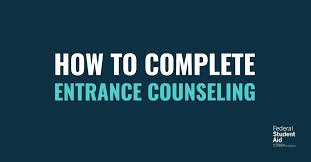Federal financial aid programs for college students include scholarships, grants, work-study programs, and loans. Among these only loans need to be repaid, making them the least attractive type of Federal aid. Nevertheless, more students participate in the loan programs that any other type because, when other programs and resources don’t cover the cost of college and borrowing is necessitated, Federal loans offer students the best terms.
Students may apply for Federal loans through the FAFSA process on the studentaid.gov website. Below are the four current Federal loan programs that address the needs of students in different circumstances, as follows:
• Direct Subsidized Loans,
• Direct Unsubsidized Loans,
• Direct PLUS Loans, and
• Direct Consolidation Loans.
When a student is approved for a Federal loan for the first time, they’re required to complete Student Loan Entrance Counseling, an online course offered by the Office of Federal Student Aid (FSA), the agency within the U.S. Education Department (ED) that’s responsible for student aid programs.
The Student Loan Entrance Counseling course is intended to make sure that students understand their rights and responsibilities regarding Federal loans prior to entering into a loan agreement. In the counseling course, students are taught what constitutes a loan, how interest is calculated, the options for repayment, and ways to avoid delinquency and default. When a student successfully completes the course, a report is sent to the colleges that they have indicated on the FAFSA. When the report is received, the student is authorized to execute loan agreements and borrow money for college.
The Cost of the Student’s Education
Module 1 of the counseling course is titled “Estimate the Cost of Your Education”. Students are taught about the direct and indirect costs of attending college and how to manage their costs in order to minimize their loan burden. The first section concerns the total cost of the college program in which the student intends to enroll so that he or she understands the total amount of money that will be needed. The following three topics are covered:
- Cost of Attendance (COA)
The COA of a college is the annual cost advertised by the college on their website and course catalog before financial aid is taken into account. Tuition and fees, room and board, and other education-related expenses (both direct and indirect) are included. Totals for the same college may vary based on choices that the student makes such as the choice of campus and major.
- Direct Costs
These are expenses that are billed to the student’s account and paid directly to the college. They include tuition and fees as well as the costs of on-campus housing and meal plans.
- Indirect Costs
Indirect costs are not paid to the college but must be covered by the student. These include books, equipment, transportation, and off-campus housing and food expenses, if applicable. Although financial aid may cover these costs, it is the student who pays the retailer, landlord, or common carrier.
Assessing a Specific College’s Cost of Attendance
The second section in Module 1 provides a way for a student to obtain an estimate of the COA of a specific college. Students can use a search grid to obtain information about any college by providing the information below:
- College Name (selected from a pull-down menu)
- Type of Tuition (In-State, Out-of-State, or Private)
- Living Arrangement (On-Campus or Off-Campus)
- Expected Years to Complete Program (1 to 6)
After the app generates results, a report is provided to the student similar to the sample below. The assumptions underlying the calculations in the report are based on data that has been provided by the college. The calculations may not reflect possible recent changes in COA such as tuition hikes. Students should check with the college’s Financial Aid Office for current information.
Estimated Cost of Attendance Per Year = $23,844
Direct Costs:
Tuition and Fees $8,364
Room and Board $10,724
Indirect Costs:
Books and Supplies $1,269
Transportation/Misc. $3,487
Estimated Cost of School per Year = $23,844
Times Expected Years to Complete = 4 years
Total Four-Year Estimated COA = $95,376
Next Post – Module 2
Module 2 of the FSA’s Student Loan Entrance Counseling course is titled “Paying for Your Education”. Students are taught about options available to pay for college including sources of aid that don’t need to be repaid such as grants and work-study programs.


Recent Comments